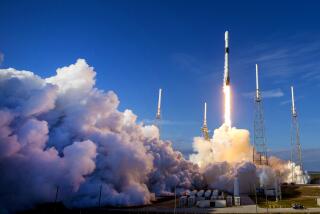New Rocket Engine Omits Flaws Tied to Blast, NASA Official Says
- Share via
HOUSTON — Early tests show that a new rocket engine design will eliminate the flaws that caused the space shuttle Challenger to blow up, a National Aeronautics and Space Administration official said Monday.
John Thomas, manager of NASA’s solid rocket motor redesign team, also said the space agency is on track toward a resumption of space flights in early 1988.
A new engine “has been tested and we are much more confident than ever before that it is a good design,” but much more testing remains to be done, Thomas said.
Challenger blew up 73 seconds after launch Jan. 28, killing all seven crew members. A presidential commission determined that a joint on the solid rocket engine leaked flame that ignited rocket propellant.
Among the factors blamed by the commission were warping of the metal parts of the joint that unsealed two rubberized O rings, and low temperatures that reduced the seals’ resilience.
Thomas and his team designed a joint with an extra lip to prevent warping, added another O ring and developed a heater to keep the joint warm. All of those elements worked well in early testing, he said.
Four full-scale tests culminating by October, 1987, begin in January, Thomas said. If the final test is successful, the shuttle will be cleared for launch in February, 1988, he said.
More to Read
Sign up for Essential California
The most important California stories and recommendations in your inbox every morning.
You may occasionally receive promotional content from the Los Angeles Times.










